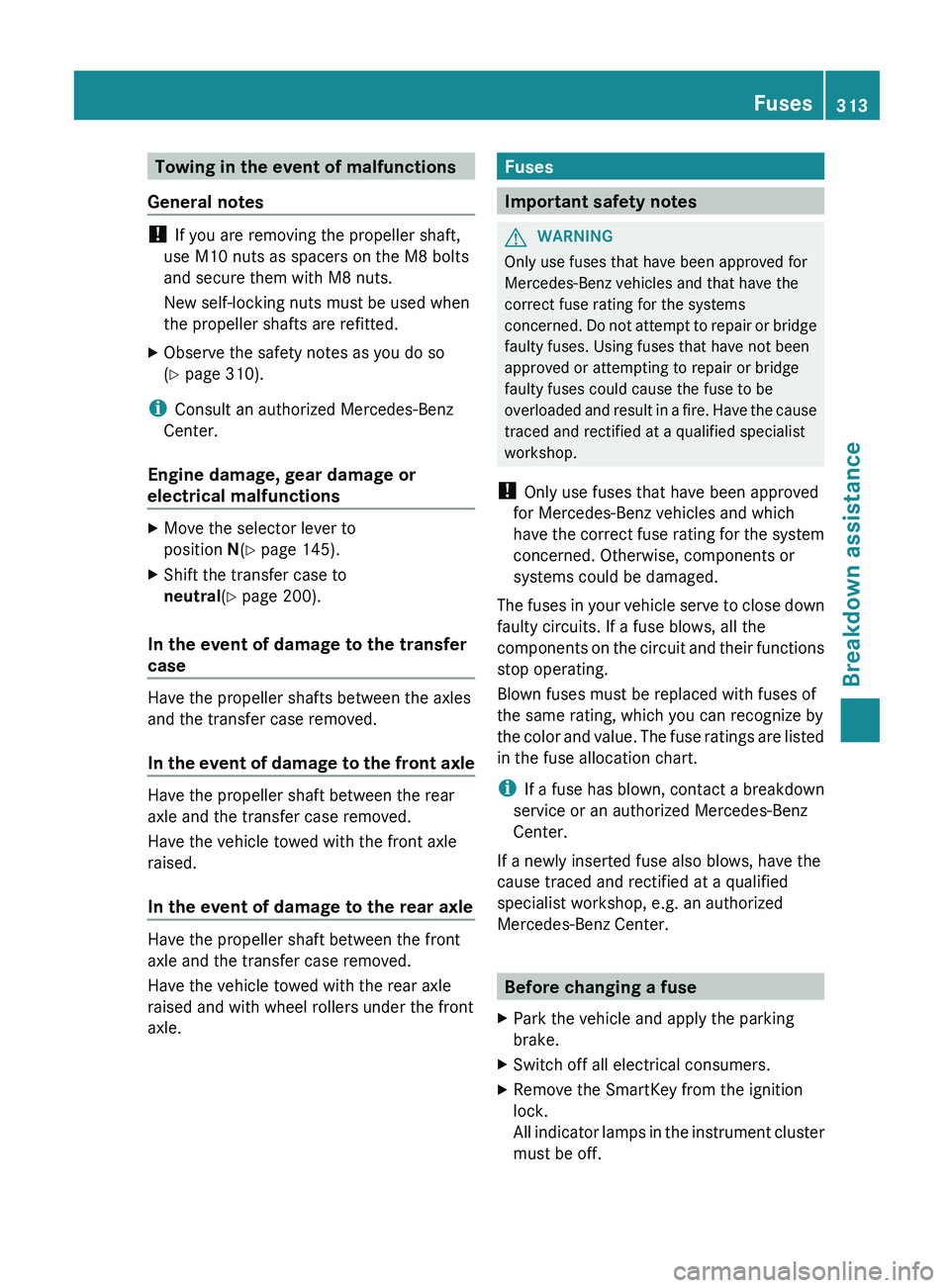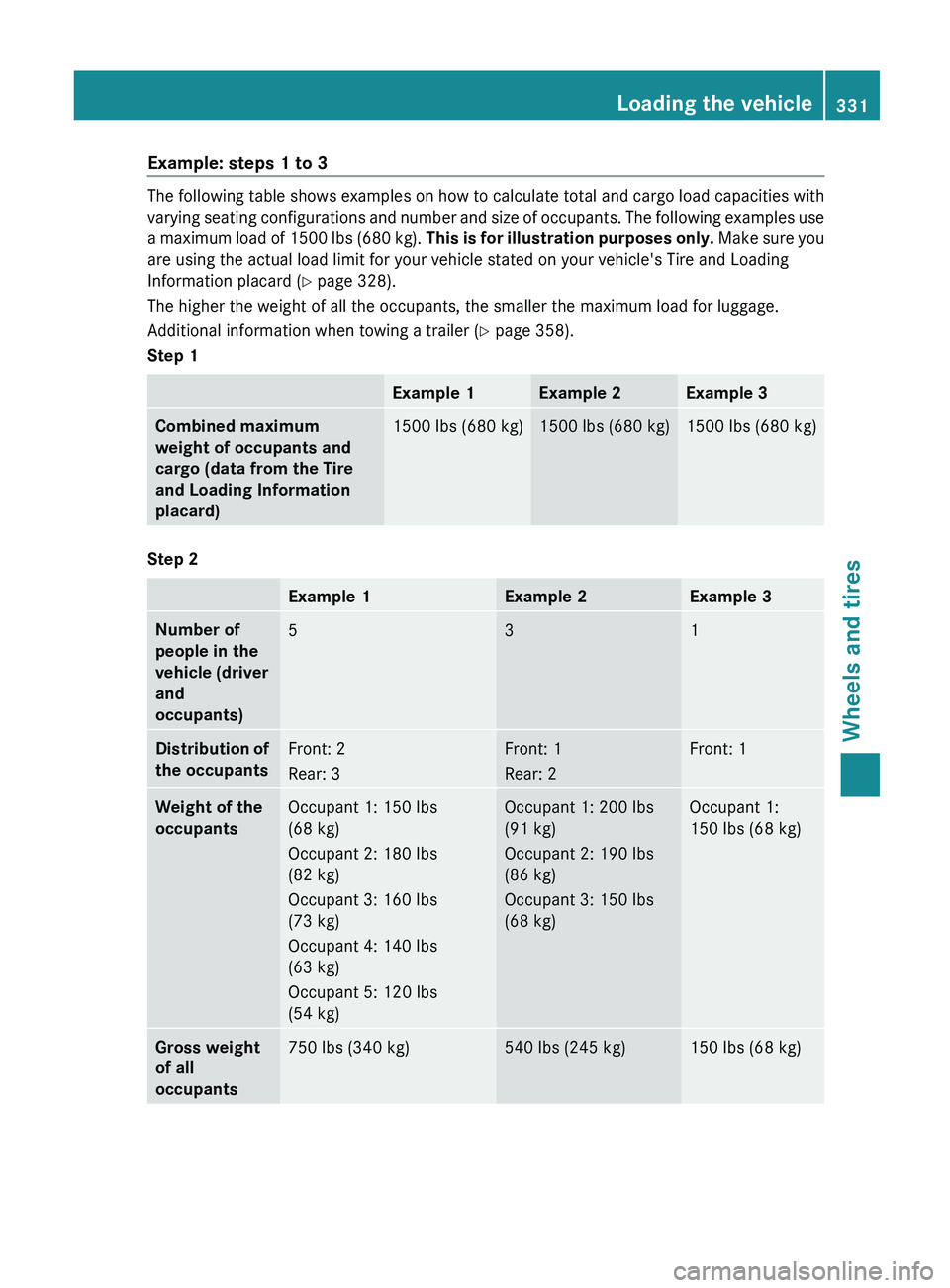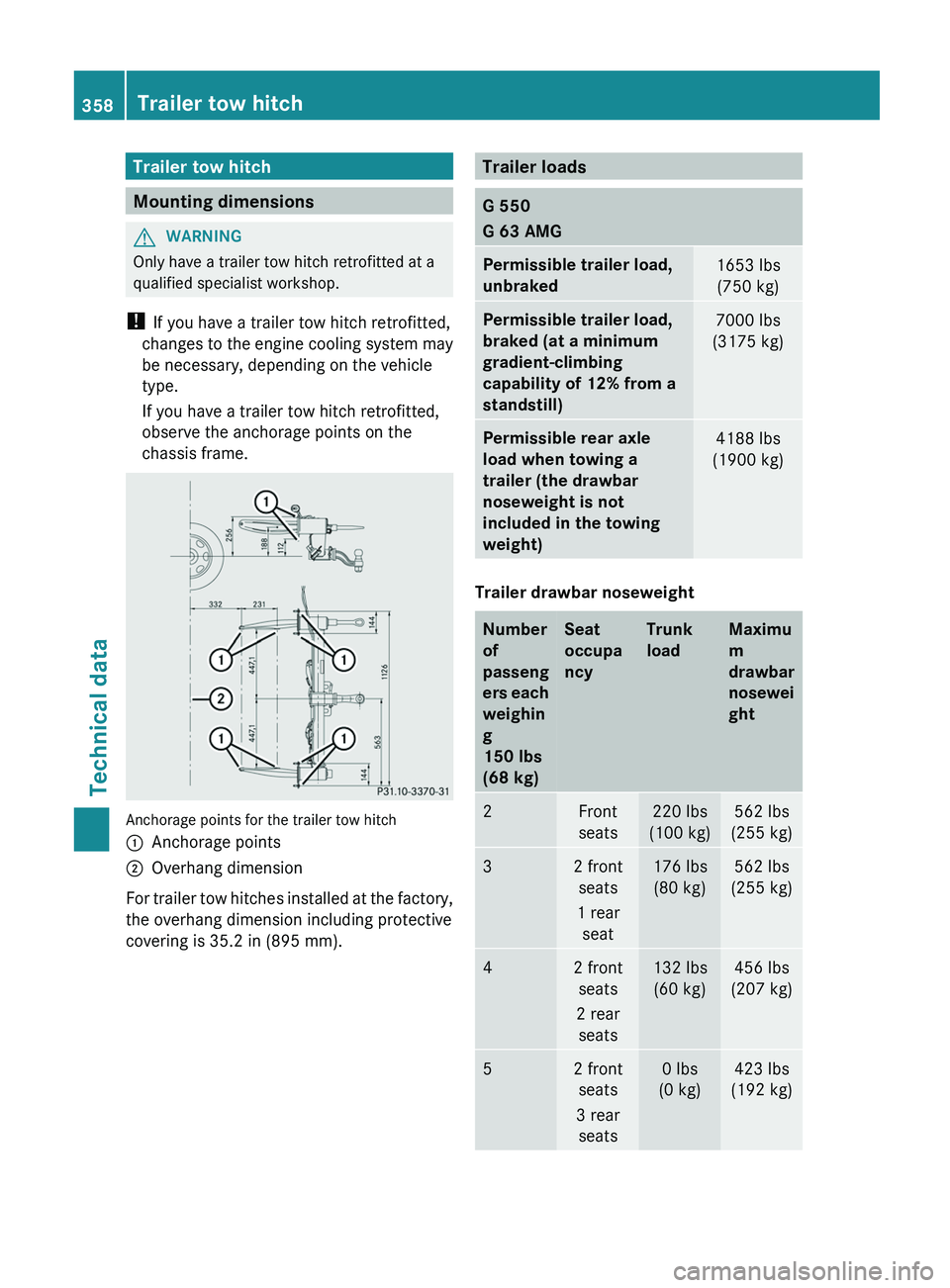Page 315 of 364

Towing in the event of malfunctions
General notes !
If you are removing the propeller shaft,
use M10 nuts as spacers on the M8 bolts
and secure them with M8 nuts.
New self-locking nuts must be used when
the propeller shafts are refitted.
X Observe the safety notes as you do so
(Y page 310).
i Consult an authorized Mercedes-Benz
Center.
Engine damage, gear damage or
electrical malfunctions X
Move the selector lever to
position N(Y page 145).
X Shift the transfer case to
neutral (Y page 200).
In the event of damage to the transfer
case Have the propeller shafts between the axles
and the transfer case removed.
In the event
of
damage to the front axleHave the propeller shaft between the rear
axle and the transfer case removed.
Have the vehicle towed with the front axle
raised.
In the event of damage to the rear axle
Have the propeller shaft between the front
axle and the transfer case removed.
Have the vehicle towed with the rear axle
raised and with wheel rollers under the front
axle. Fuses
Important safety notes
G
WARNING
Only use fuses that have been approved for
Mercedes-Benz vehicles and that have the
correct fuse rating for the systems
concerned. Do not attempt
to repair or bridge
faulty fuses. Using fuses that have not been
approved or attempting to repair or bridge
faulty fuses could cause the fuse to be
overloaded and result in a fire. Have the cause
traced and rectified at a qualified specialist
workshop.
! Only use fuses that have been approved
for Mercedes-Benz vehicles and which
have the correct fuse rating for the system
concerned. Otherwise, components or
systems could be damaged.
The fuses in your vehicle serve to close down
faulty circuits. If a fuse blows, all the
components on the circuit and their functions
stop operating.
Blown fuses must be replaced with fuses of
the same rating, which you can recognize by
the color and value. The fuse ratings are listed
in the fuse allocation chart.
i If a fuse has blown, contact a breakdown
service or an authorized Mercedes-Benz
Center.
If a newly inserted fuse also blows, have the
cause traced and rectified at a qualified
specialist workshop, e.g. an authorized
Mercedes-Benz Center. Before changing a fuse
X Park the vehicle and apply the parking
brake.
X Switch off all electrical consumers.
X Remove the SmartKey from the ignition
lock.
All indicator lamps in
the instrument cluster
must be off. Fuses
313
Breakdown assistance Z
Page 332 of 364
X
Step 4: The resulting figure equals the
available amount of cargo
and luggage load
capacity. For example, if the "XXX" amount
equals 1400 lbs and there will be five 150-
pound passengers in your vehicle, the
amount of available cargo and luggage load
capacity is 650 lbs (1400 – 750 (5 x 150)
= 650 lbs).
X Step 5: Determine the combined weight of
luggage and cargo being loaded on the
vehicle. That weight
may not safely exceed
the available cargo and luggage load
capacity calculated in step 4.
X Step 6 (if applicable): If your vehicle will
be towing a trailer, load from your trailer
will be transferred to your vehicle. This
reduces the available cargo and luggage
load capacity of your vehicle
(Y page 358). 330
Loading the vehicle
Wheels and tires
Page 333 of 364

Example: steps 1 to 3
The following table shows examples on how to calculate total and cargo load capacities with
varying seating configurations
and
number and size of occupants. The following examples use
a maximum load of 1500 lbs (680 kg). This is for illustration purposes only. Make sure you
are using the actual load limit for your vehicle stated on your vehicle's Tire and Loading
Information placard (Y page 328).
The higher the weight of all the occupants, the smaller the maximum load for luggage.
Additional information when towing a trailer ( Y page 358).
Step 1 Example 1 Example 2 Example 3
Combined maximum
weight of occupants and
cargo (data from the Tire
and Loading Information
placard)
1500 lbs (680 kg) 1500 lbs (680 kg) 1500 lbs (680 kg)
Step 2
Example 1 Example 2 Example 3
Number of
people in the
vehicle (driver
and
occupants)
5 3 1
Distribution of
the occupants
Front: 2
Rear: 3 Front: 1
Rear: 2 Front: 1
Weight of the
occupants
Occupant 1: 150 lbs
(68 kg)
Occupant 2: 180 lbs
(82 kg)
Occupant 3: 160 lbs(73 kg)
Occupant 4: 140 lbs(63 kg)
Occupant 5:
120 lbs
(54 kg) Occupant 1: 200 lbs
(91 kg)
Occupant 2: 190 lbs
(86 kg)
Occupant 3: 150 lbs(68 kg) Occupant 1:
150 lbs (68 kg)
Gross weight
of all
occupants
750 lbs (340 kg) 540 lbs (245 kg) 150 lbs (68 kg)Loading the vehicle
331
Wheels and tires Z
Page 360 of 364

Trailer tow hitch
Mounting dimensions
G
WARNING
Only have a trailer tow hitch retrofitted at a
qualified specialist workshop.
! If you have a trailer tow hitch retrofitted,
changes to the engine
cooling system may
be necessary, depending on the vehicle
type.
If you have a trailer tow hitch retrofitted,
observe the anchorage points on the
chassis frame. Anchorage points for the trailer tow hitch
0043
Anchorage points
0044 Overhang dimension
For trailer tow hitches installed at the factory,
the overhang dimension including protective
covering is 35.2 in (895 mm). Trailer loads
G 550
G 63 AMG
Permissible trailer load,
unbraked
1653 lbs
(750 kg) Permissible trailer load,
braked (at a minimum
gradient-climbing
capability of 12% from a
standstill)
7000 lbs
(3175 kg) Permissible rear axle
load when towing a
trailer (the drawbar
noseweight is not
included in the towing
weight)
4188 lbs
(1900 kg) Trailer drawbar noseweight
Number
of
passeng
ers each
weighin
g
150 lbs
(68 kg) Seat
occupa
ncy Trunk
load Maximu
m
drawbar
nosewei
ght
2 Front
seats 220 lbs
(100 kg) 562 lbs
(255 kg) 3 2 front
seats
1 rear seat 176 lbs
(80 kg) 562 lbs
(255 kg) 4 2 front
seats
2 rear seats 132 lbs
(60 kg) 456 lbs
(207 kg) 5 2 front
seats
3 rear seats 0 lbs
(0 kg) 423 lbs
(192 kg) 358
Trailer tow hitch
Technical data